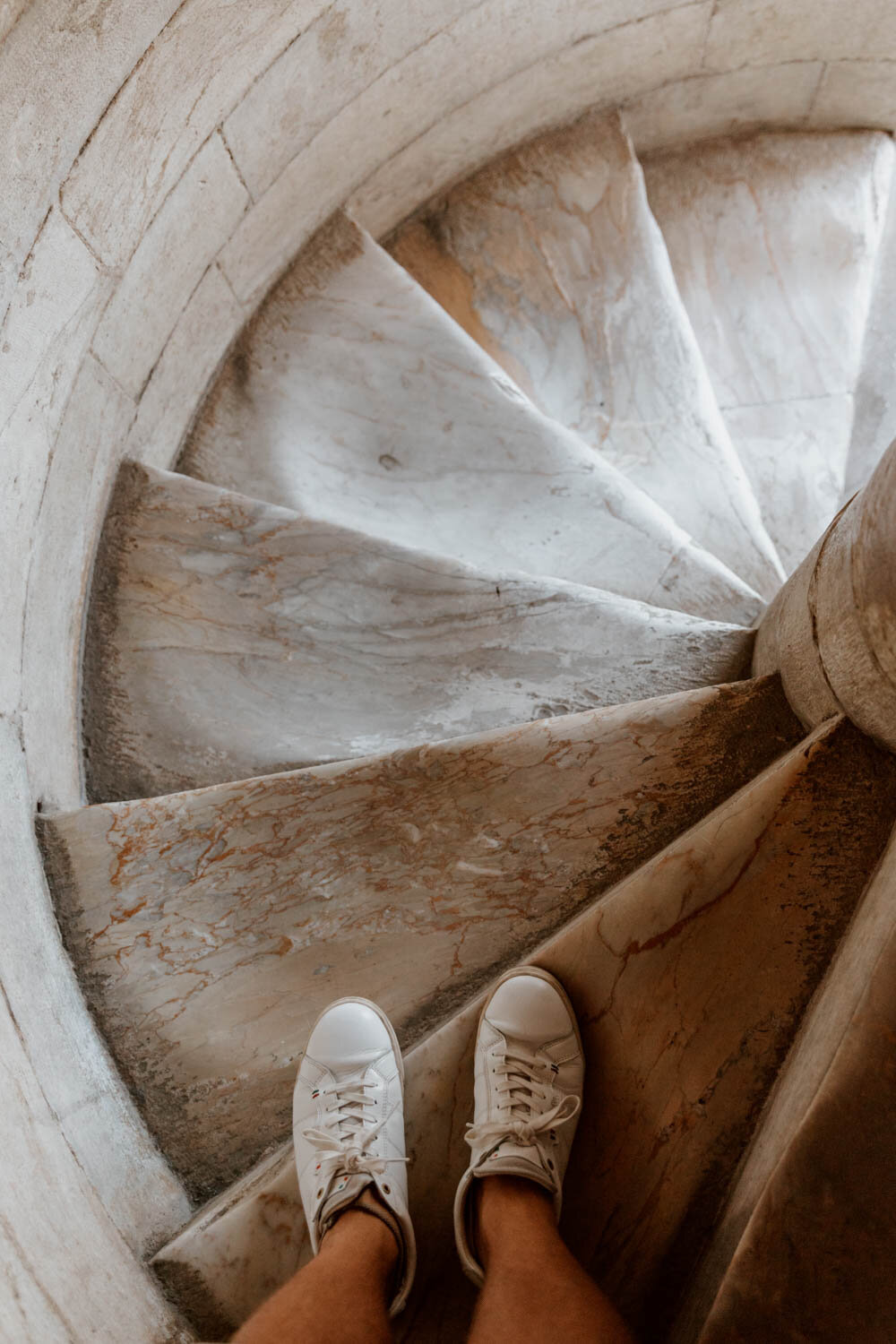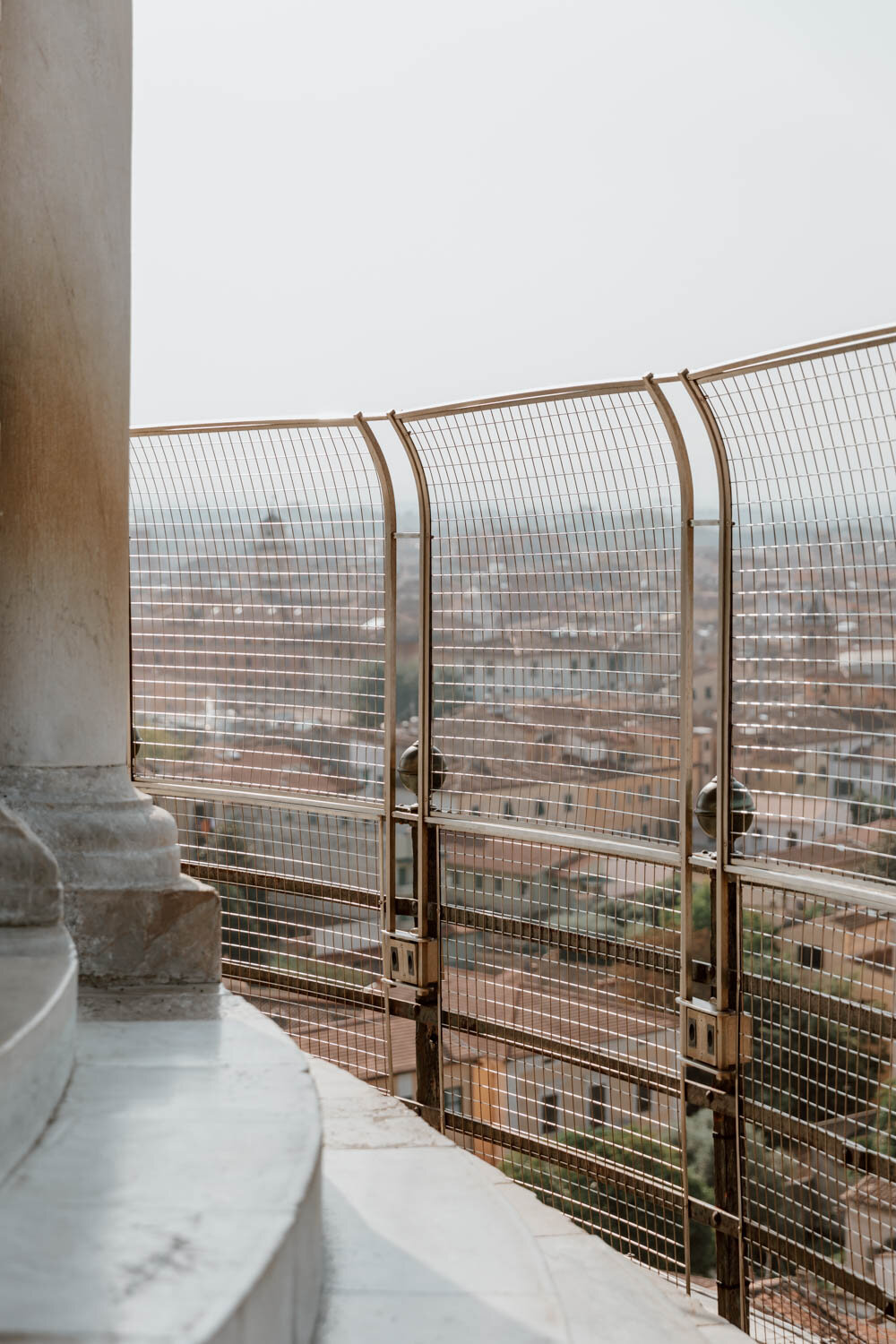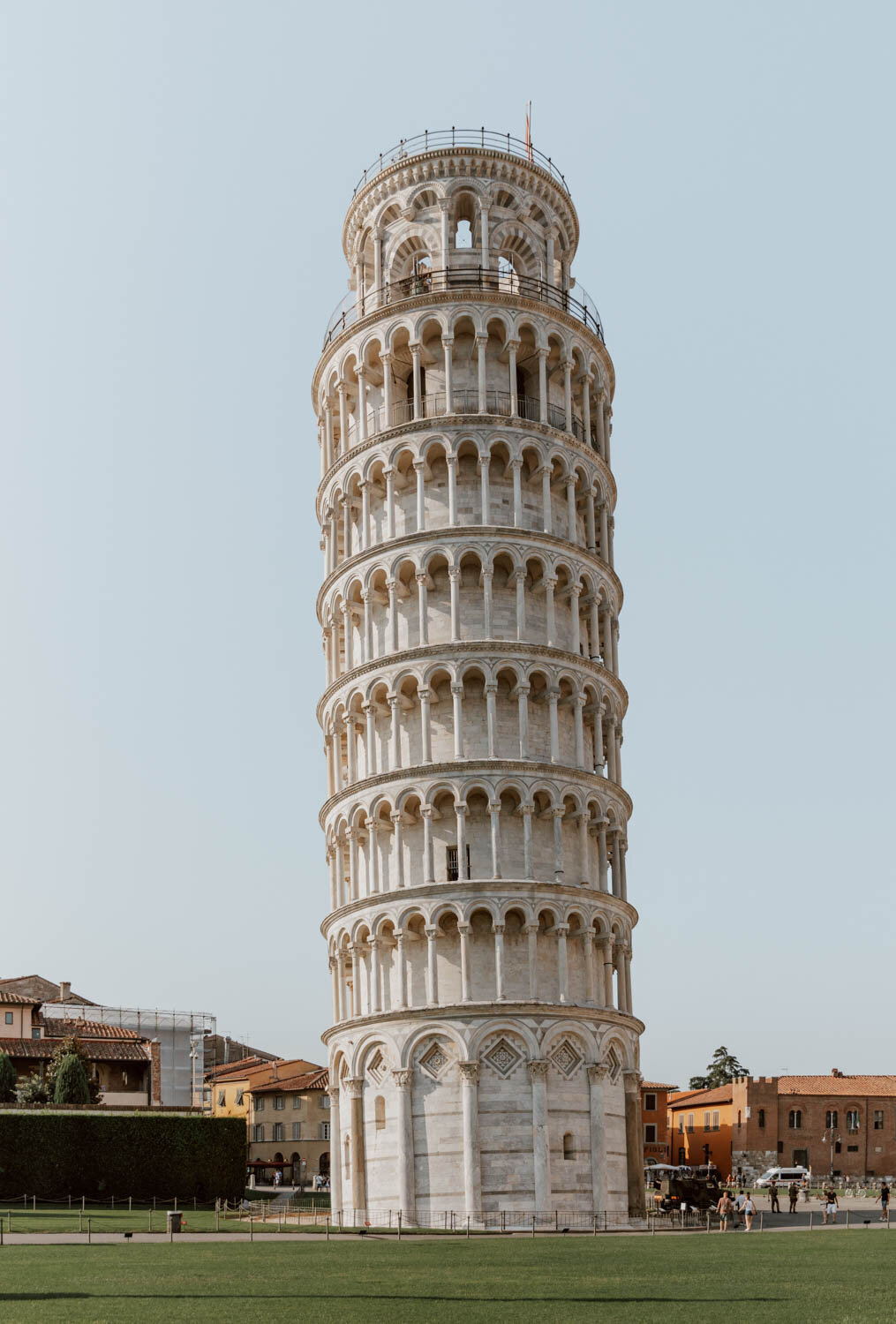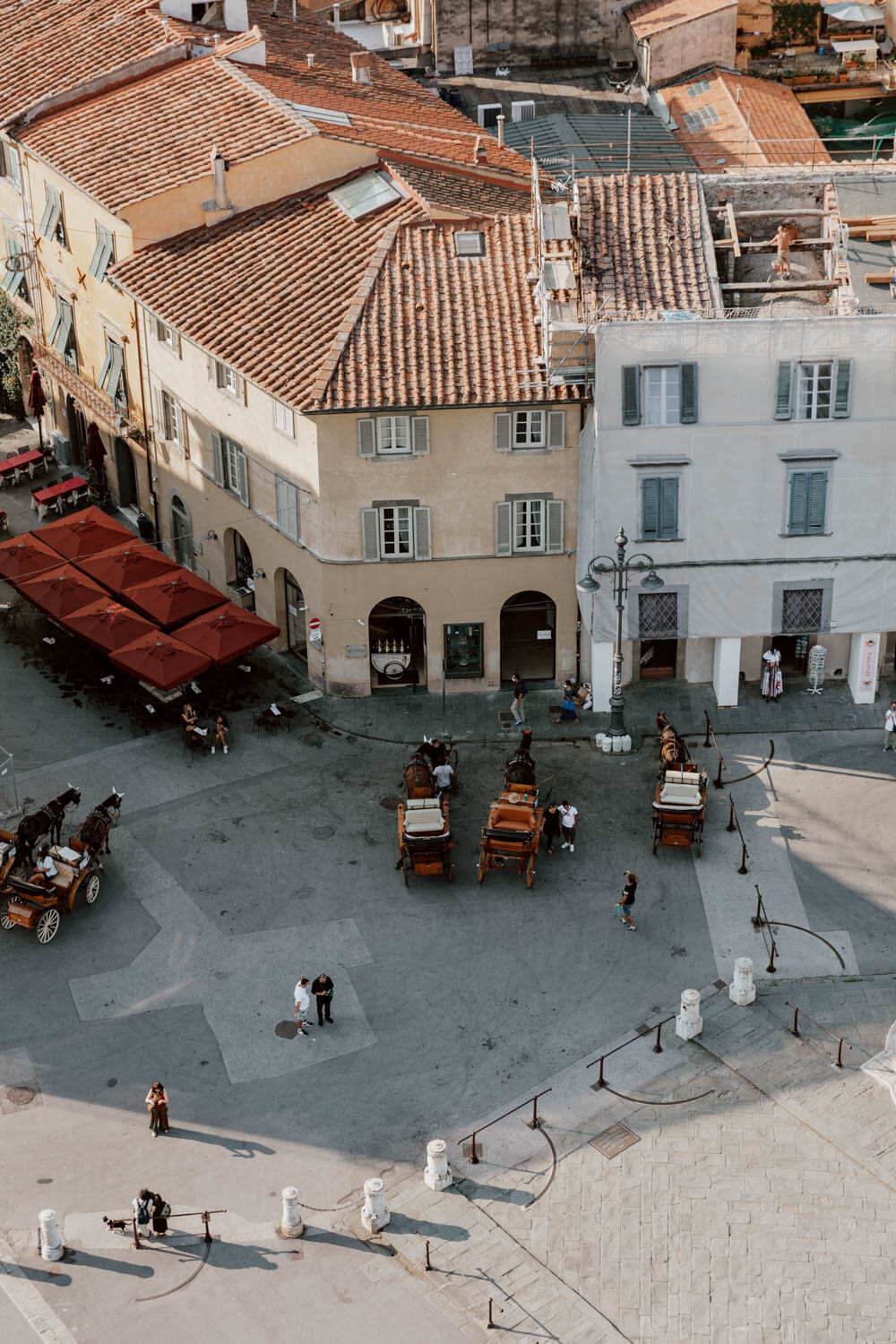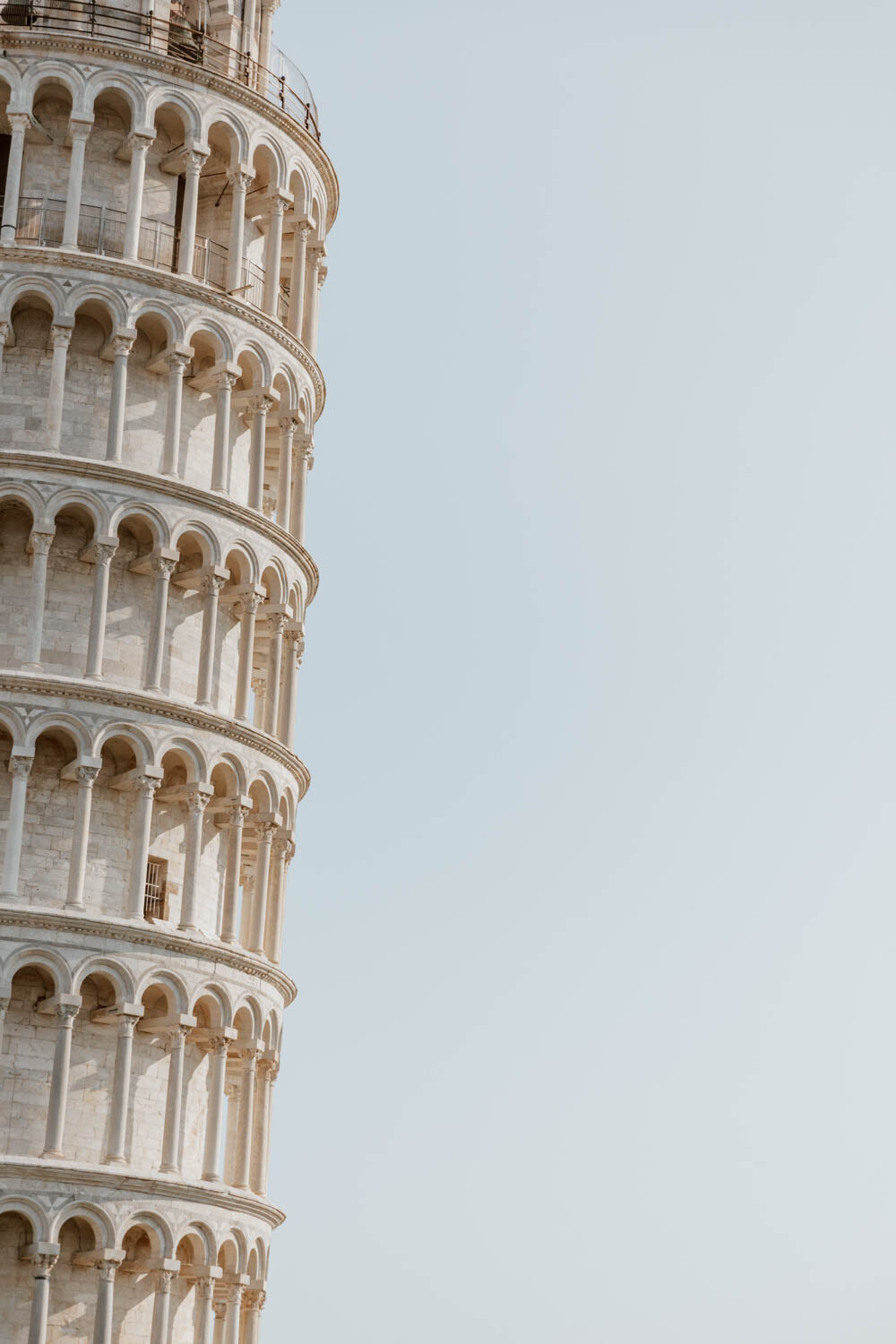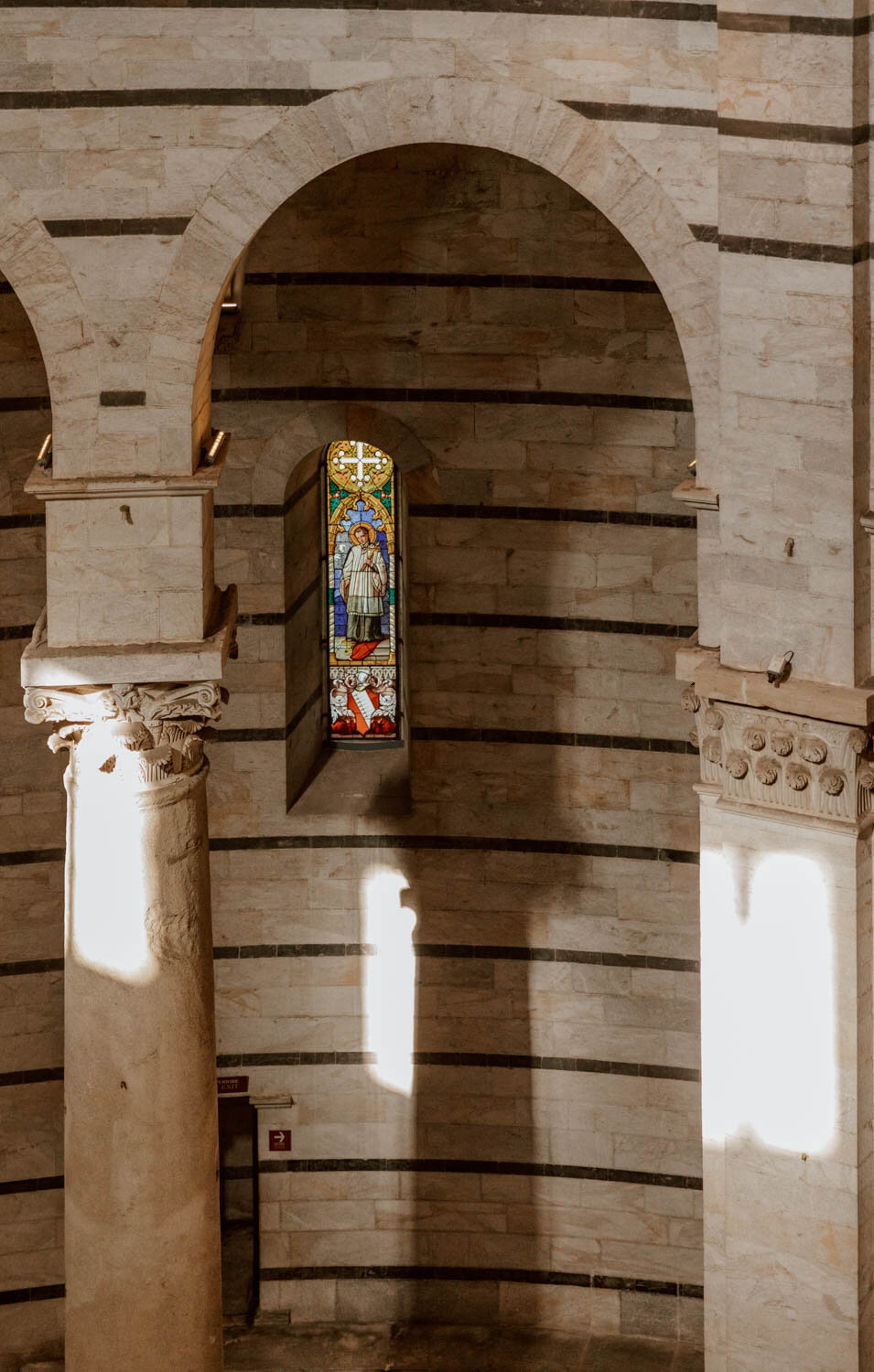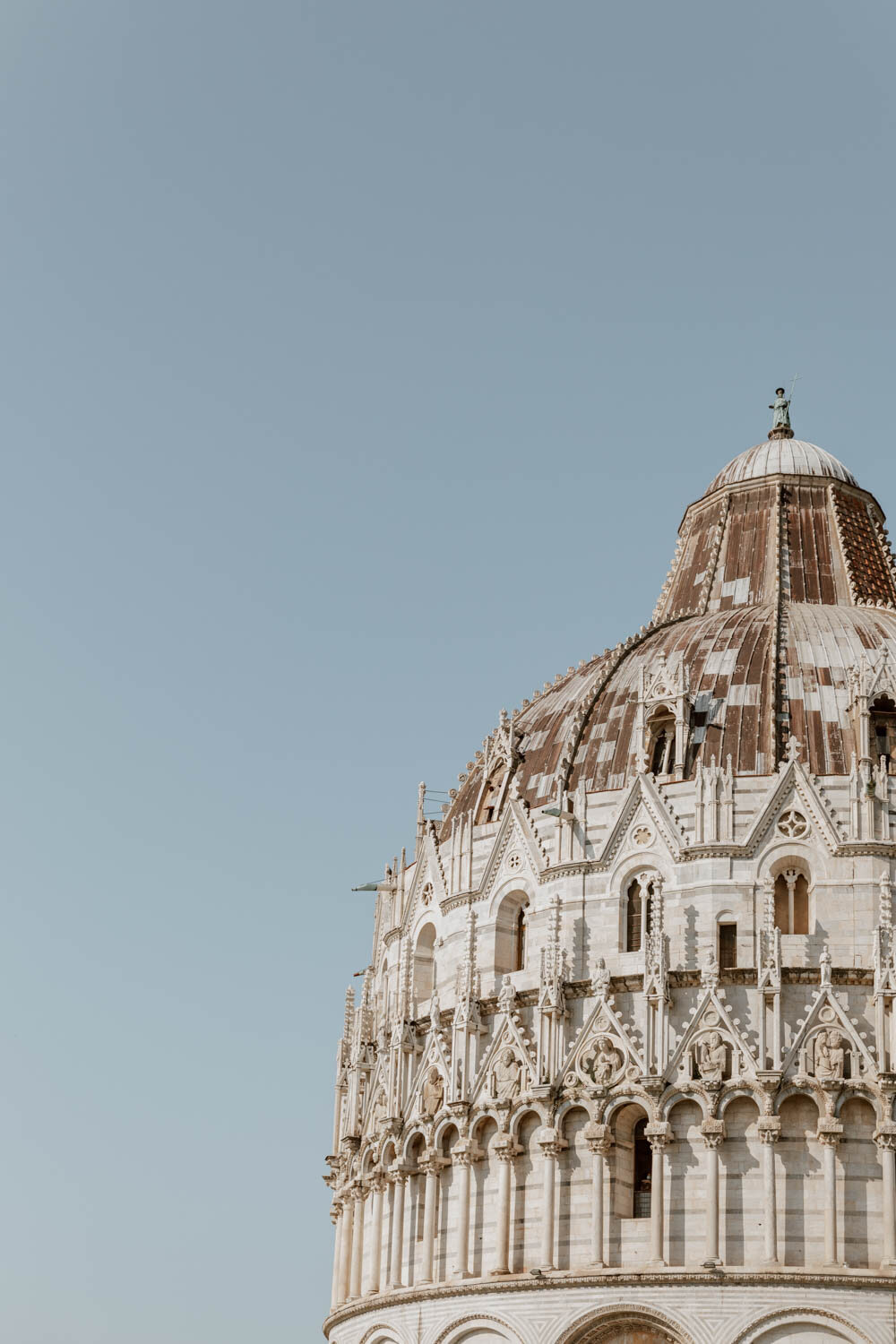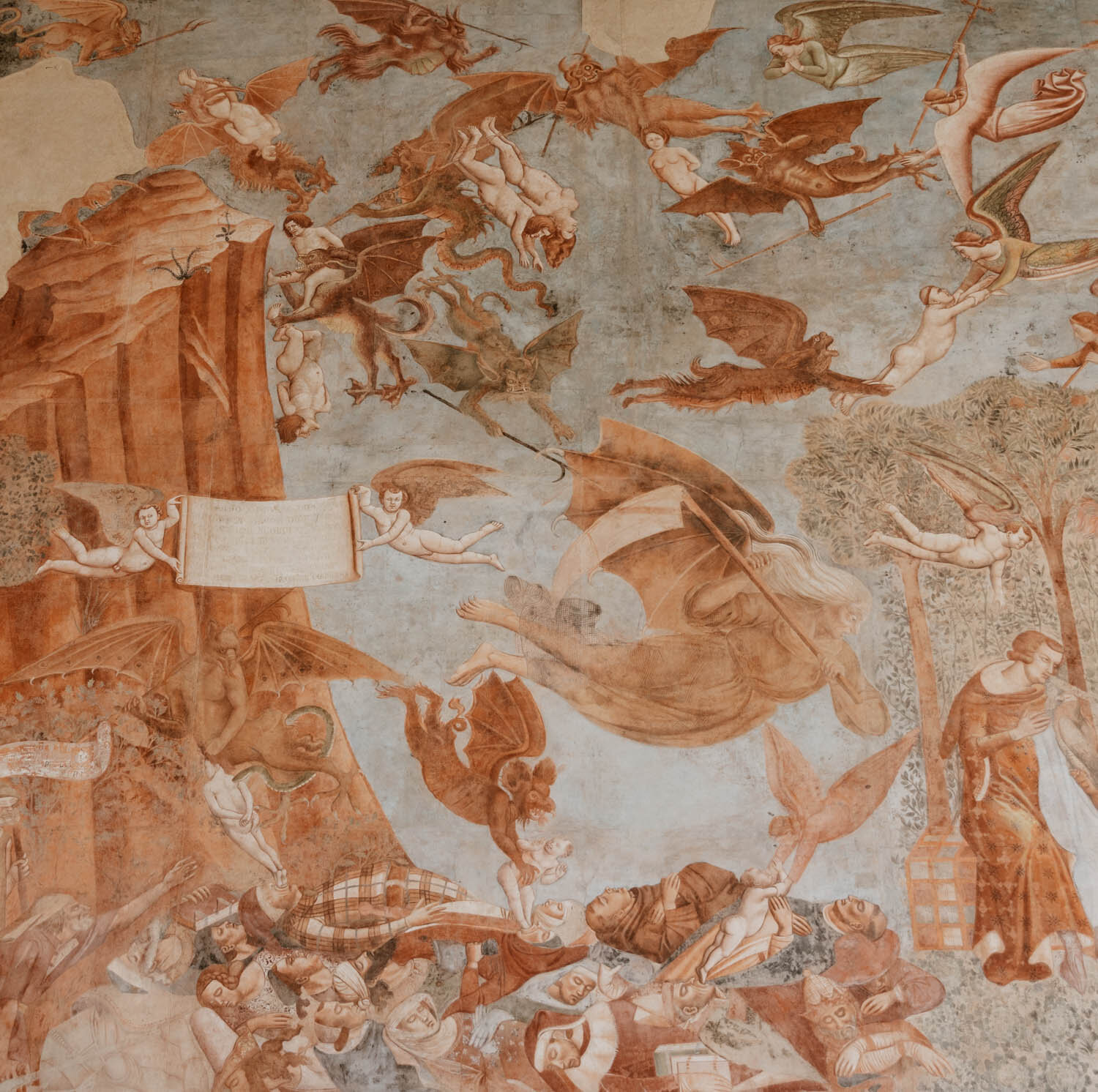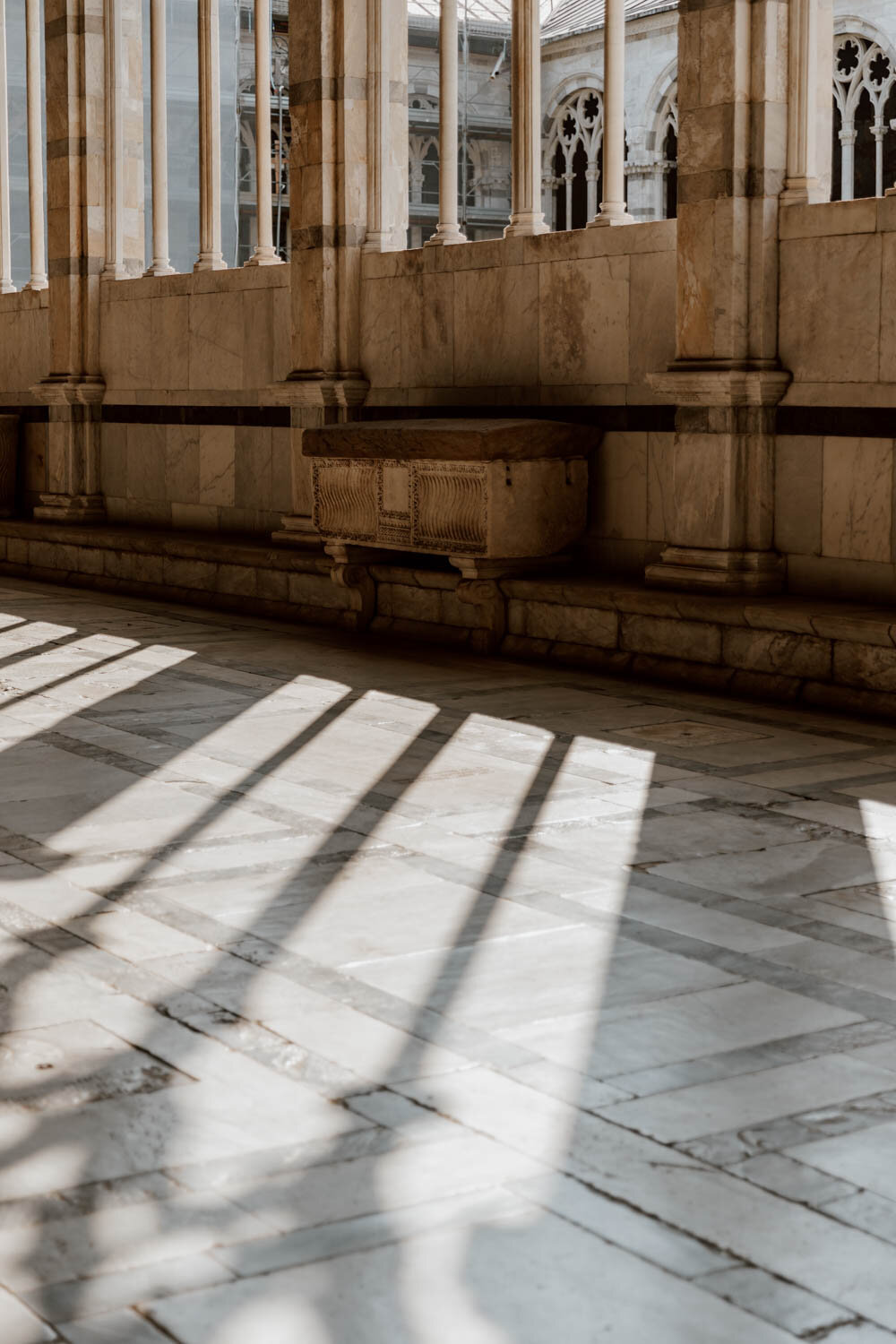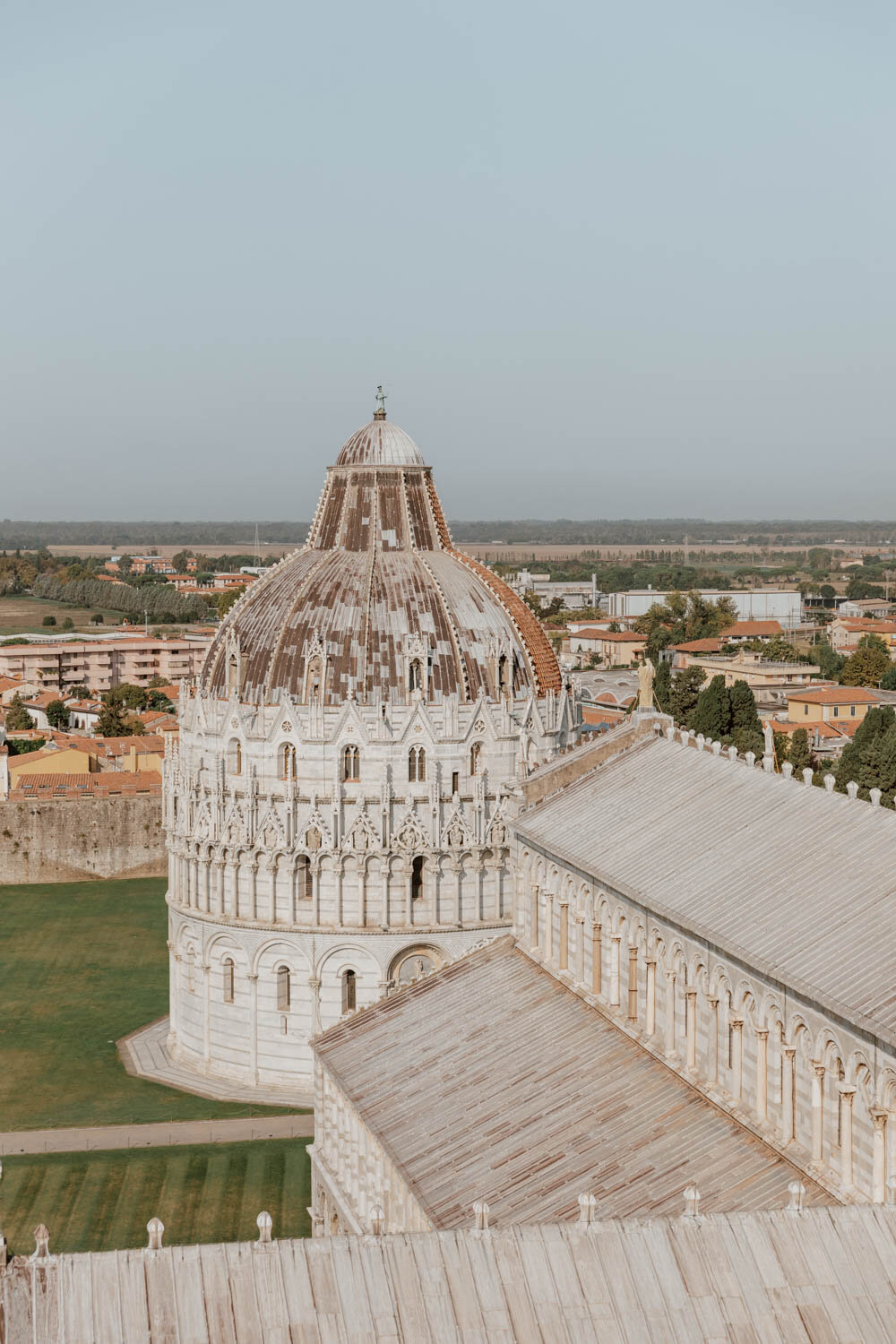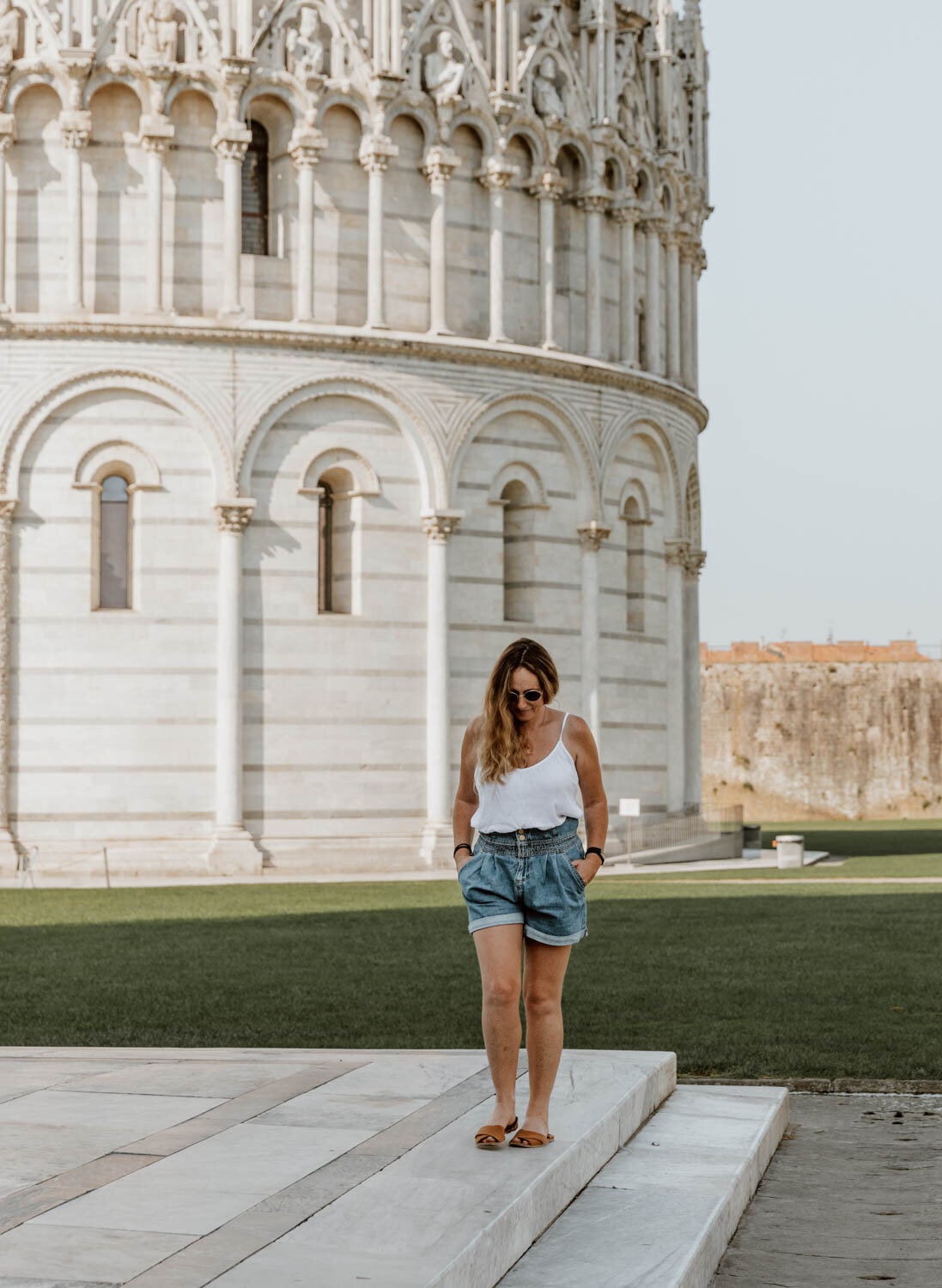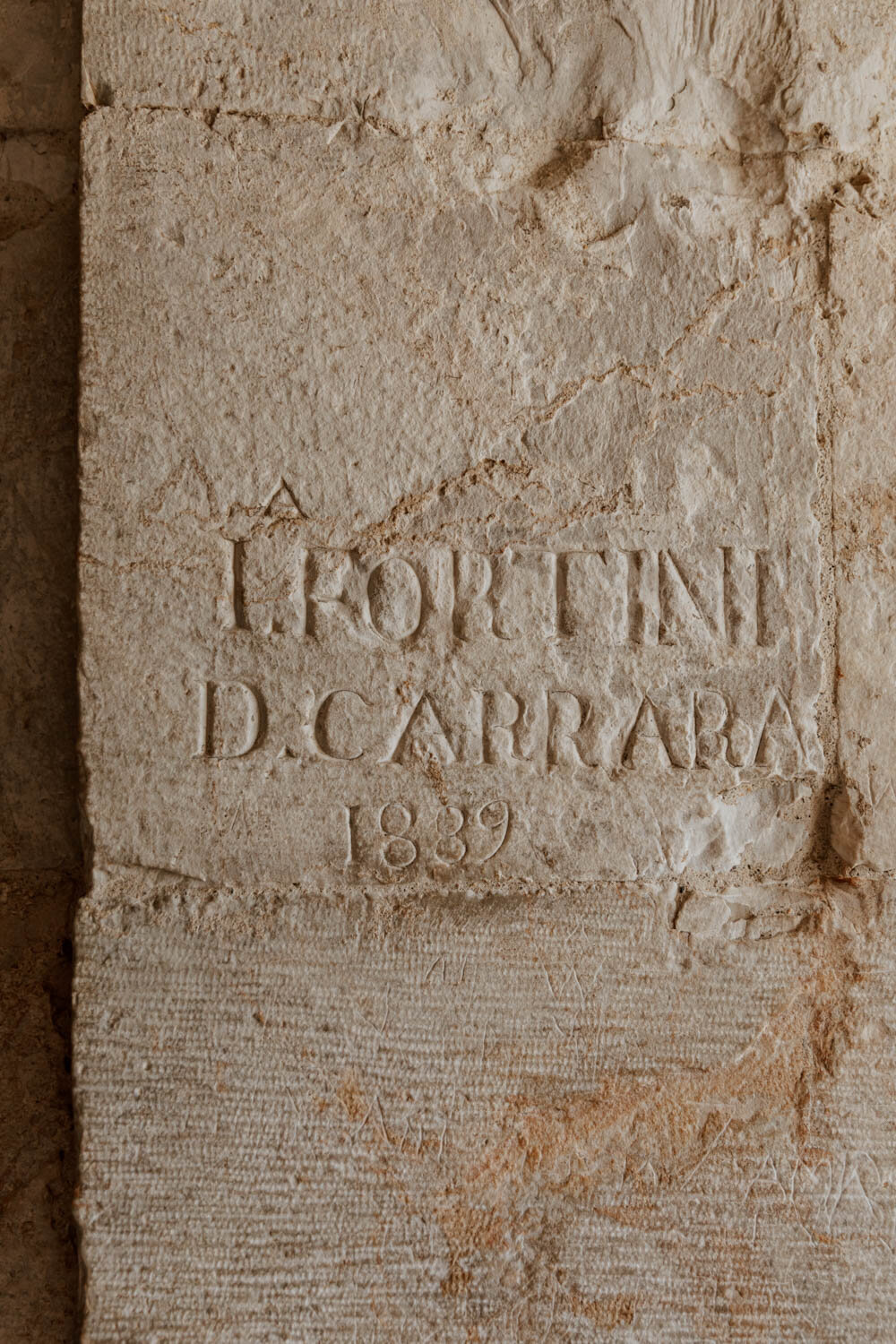Planning to visit to the most famous tower in Italy?
Our guide gives you the intriguing history behind the Leaning Tower of Pisa’s iconic tilt, plus essential advice how to visit it on an independent day trip or stay in Pisa.
When does it become important to be wrong, rather than right?
In the early 90s, a team of expert engineers were tasked with taking the Leaning Tower of Pisa back from its tipping point. Computer models had predicted that the maximum incline the structure could tolerate before toppling over in an explosion of white marble, was an angle 5.44 degrees.
Before work started, it was at 5.5 degrees.
This tower's treacherous trajectory, its seeming desire to slope southward millimetre by millimetre over nearly a millennium of existence, has befuddled and beguiled everyone throughout the ages.
Was it designed to slant? Why hasn't anyone fixed it? How on earth does it not fall over?
In more recent years though, curiosity about these questions has perhaps given way to those famous pictures everyone and their mother takes when first confronted with Italy's most famous tower. You'll know the ones: holding it up, pushing against it, pointing at its top, the funny perspectives, and quite a few naughty versions making the most of the tower's resemblance to...actually, we don't need to explain that in detail here.
And yet those engineers, aided by technological advancements, had finally devised a way to reverse the downward trend. Their delicate removal of soil from the northern end and a system of lead weights and supports saw the tower creak back, unplugging itself and eventually settling in the soil at a much more stable 4 degree slant.
Why stop there though? Because, after all, nobody would really care about just another straight tower in Italy; it was far more important to preserve the 12th century mistake rather than to correct it.
//
Everyone knows about the tower and has seen those photos, but the truth is that many travellers are underwhelmed by their visit. And that's probably because, well, its fame and photo opportunities precede it bit too much, turning the Campo dei Miracoli into a little bit of a open-air theme park.
And, if there's on thing for certain, a crooked belltower and an 11th century cathedral housed within a UNESCO World Heritage site definitely ain't Disneyland (thank god).
Our personal guide to the Leaning Tower of Pisa isn't about stopping people taking those photos or being a party pooper. Instead, it's about making sure you're perfectly prepared to make the most of your time at one of Italy's most iconic attractions - and ensuring that you don't miss out on some of its most fascinating, underappreciated aspects.
After our own experience last summer, we've also shared all the essential advice for you to visit to the Leaning Tower of Pisa, whether as a day trip or during a longer stay in the Tuscan city, with tips on the convoluted ticketing system, transport connections, and why you really should go inside...
In a rush? Buy your Leaning Tower of Pisa entry ticket here.
the essentials
// Started in 1173, completed in 1370
// 55.8 metres tall on its lowest side, 56.67 metres on its highest
// Part of a single UNESCO World Heritage Site, which includes Pisa Cathedral and the San Giovanni Baptistry
// Entry to the Tower requires advance ticket reservations
// Possible to visit on a Pisa day trip from Lucca, Florence, Bologna, and La Spezia
A Short, Slanted History of The Tower of Pisa
It was doomed from the very beginning.
Fuelled by funds from foreign (at that time) wars in Sicily, the city of Pisa set out to build a complex which would set them apart from rivals: the walled Piazza del Duomo. Housing its stunning Cathedral and Baptistry, the belltower was the third of the triumvirate to be built - and the least important.
Campanili (belltowers) are commonplace throughout Italy. Some have become famous in their own right (such as those in Venice and Florence), but were very much there to act as complement to churches and cathedrals rather than be the star attraction.
If the builders of Pisa's own campanile had not grossly underestimated the foundations upon which they laid their own foundations in 1173, then the chances are that far fewer of us would show more than a passing interest in the Torre di Pisa.
The soil composition here was a soft, soppy mix of fine sand, clay, and shells, and indeed the name 'Pisa' was given by the ancient Greeks as it meant 'marshy land'. This wasn’t unknown at the time, but the building work commenced with only a shallow three metre underpinning. Within the first five years, with only three tiers completed, the structure started to sink.
It would take a century of war to prevent its collapse.
To The Left A Bit, To The Right A bit
The fundamental mistake which would come to define Pisa's destiny was left as ‘tomorrow’s problem', as the city entered various long-running conflicts with neighbouring powers of Florence, Genoa, and Lucca. With no extra weight or layers added, the ground caked and solidified, settling in such a way that the inevitable collapse became not so inevitable after all.
Construction restarted in 1272 and attempts to compensate for the slant were continual: floors on one side built higher, sections built squint to square it off, probably more than a few prayers. Yet, six years and four storeys later, the growing tower was teetering almost three feet south. When the bell tower on the eighth and final storey was installed, they built it northward in the hope of evening things out.
And yet the Tower of Pisa would simply not relent in the face of ingenuity.
Over two hundreds years of stop-start building, each attempt to even things out only made it worse, with the extra weight seeing the unstable ground underneath squelch and squirm to give way. A change here would lead to a shift there, a pivot here see a slant appear there, a zig here resulted in a zag there.
Leaning, it appeared, is what this Italian tower was destined to do.
And things could only go downhill from there (or on a slightly upward gradient, depending on where you were standing…)
A Dictator & A War
Projects over the centuries proved futile.
Benito Mussolini, Italy's fascist dictator, viewed the monument as a stain on Italian culture and identity, something to be mocked and derided rather than celebrated or promoted on postcards. Under his orders, a team of engineers set out to make it straight in 1934 by pumping 200 tonnes of cement into its foundations.
The tower creaked further south, perhaps its own version of protestation to the doctrine which would tear Europe's foundations apart over the next decade.
Indeed, it was World War Two which would pose the greatest threat to the Tower of Pisa's existence; six simple words would have seen it obliterated.
Fearful that the vantage point of the campanile was being used by German snipers to pick off the American troops tasked with liberating Pisa, orders were issued to take it down under a barrage of artillery. The young, short-sighted American GI tasked with confirming the presence of Nazis amongst the bells was however spellbound by the sight before him. He couldn't bring himself to utter the signal "This is Able George One. Fire", and destroy something so enchantingly beautiful.
A Rescue Attempt & Closure
In 1964, the Italian government went public and international to ask for help. It was clear that luck, miracles, or a seeming-resistance to gravity would one day run out and the city would lose not only the key pillar of its tourist income, but a graceful, elegant piece of its heritage.
Their mandate was clear: the Leaning Tower of Pisa had to be stabilised, but in no circumstances should it be straightened.
Several projects attempted it, and yet the precarious pursuit of partial perfection in Pisa was utterly pointless. The tower leaned more than before and, due to the seriousness of the situation and safety concerns, access to it was closed to visitors for the first time in its 800-year history (yes, you could go inside and up the Pisa Tower and, spoiler alert, you still can!)
Finally, it was that team in the 90s, via computer models, drills, weights, and a cable harness ensuring the tower couldn’t fall, that found a way where all others had failed. Following a method proposed by British engineer John Burland, they slowly extracted the unpredictable soil from the northern side, allowing the tower to slowly creak back on itself and settle.
Millimetre by millimetre, inch by inch.
By the time it was reopened to visitors in 2001, the slant had been reduced by 15.95 inches, at a cost of £200 million.
Yet, crucially, to the first-timer’s eye the tower still looks wonky as hell.
Will The Tower of Pisa Fall Over?
The plan from the outset was never to make the tower lean and, if history had taken a different course in the 12th century, then perhaps the original foundations would have collapsed within a year or two’s work, and eventually replaced with a stronger, sturdier structure.
Yet, once a tower starts off at quite a dramatic slope and becomes a global icon because of it, there is no appetite for this centuries-old mistake to be corrected.
The signature slant must remain because, well, how many people would wish to take photos in front of ‘The Tower of Pisa Which Used To Lean’.
The steps taken in the 1990s are viewed as the most important for the tower’s preservation to date, and it’s hoped that intervention has given the structure at least another 200 to 300 years of life. It may still look like it could topple like a house of cards at any moment, but it is actually, ever so slowly, tilting closer to the north each day.
It is also “the most monitored monument in the world”, with a team dedicated to keeping an eye on its health and over a hundred sensors measuring its vitals every hour.
Concerns do remain though around the integrity of the foundations, given the weight and shifting trajectory they’ve had to carry for so long. The risk of earthquakes also can’t be forgotten (though, ironically, the shifting soil is responsible for helping the Tower survive at least four strong earthquakes).
Therefore, perhaps now is the time to spare a thought for Bonanno Pisano. It had long been a mystery who had designed the Tower of Pisa, but it was recently solved with a quite remarkable discovery at the site where everything started. A faded Latin inscription on a stone found near the foot of the tower, forgotten in that soft cursed soil, proclaimed: “I, who constructed a work which is admirable and above all others, am the citizen of Pisa known as Bonanno”.
Alas Bonnano, perhaps driven by the shame of those squint first three storeys, would fade from the scene into relative obscurity. Though he was buried within the grounds of Piazza del Duomo, close to his flawed masterpiece, he would never see his tower built nor understand the fame his work would accrue.
And that not one person wishes to correct his mistake.
How To Visit The Leaning Tower of Pisa
| An Essential Guide
‘If anyone knows how to turn a disaster into a tourist attraction, it's Italians" - Trevor Noah
There are other towers which lean in Italy. There are other towers which lean at even more of an acute angle in Europe.
And yet, they do not receive around five million visitors a year.
Perhaps it’s because of its location in Italy - close to the Renaissance wanders of Florence, not too far from the walled city of Lucca, a train ride from the Cinque Terre, driving distance from vineyard retreats in the Tuscan hills - which means Pisa’s will always be the biggest tourist draw amongst the towers.
However, we also reckon an understated reason is because of that elegant beauty which so captivated a young American GI. Once you get past the lean, it’s the delicate marble pillars, the intricate patterning, the ambition of the hypnotic six external arcades. Indeed, there is an argument that the fuss about the fault actually masks something that is so architecturally and aesthetically wonderful.
Yet, and this is no exaggeration, due to the popularity of taking certain types of photos, many tourists spend the majority of time with their back to the tower.
As we mentioned, many people leave Pisa distinctly underwhelmed. They have that funny picture for Facebook or Instagram, but the whole reason of going to the city was wrapped up in one squint monument which can be seen, photographed, and left within the space of five minutes. Going to Pisa, in some traveller circles, is actually put forward as a waste of time.
We both actually had incredibly low expectations for our day trip to Pisa, with the sense that it had to be done rather than something we were eagerly anticipating. However, craning our necks and going inside it left a remarkable impression on us - and that’s before we started on the the treasures which lay only a hop, skip, and a jump from the tower itself.
This is what you need to know to plan your own visit to the Leaning Tower of Pisa.
Travelling to Pisa
You can make your way to Pisa by plane, train, and rental car.
Its international airport, also called Galileo Galilei Airport (Google Maps), is a 10-minute train journey to Pisa Centrale train station. If taking this option, then it makes sense to base yourself in Pisa for a night or longer.
Pisa is also an easy day trip from elsewhere in northern Italy, with your best option being to hop on one of the regular, affordable train services to Pisa Centrale and walk 25 minutes (2 kms) across the Arno river to Piazza del Duomo and the tower.
If you have mobility issues, you can hop on the LAM Rossa bus just outside the station. Make sure it’s going in the direction of Park Pietrasantina, not Ospedale Cisanello, and get off at the ‘Torre’ stop by Piazza dei Miracoli. If you buy the ticket at the machines before boarding it’s €1.70, but it can be purchased on board for €2 (it’s best to buy it beforehand to save time or faff, and always remember to validate the ticket in the little machine on board).
There’s also paid luggage storage within Pisa Centrale.
Alternatively, get off earlier / later at Pisa San Rossore station, which is much smaller, quieter, and lesser served, but is only a 15 minute (1 km) walk; just note that all services will stop here. We didn’t visit this station, but please be aware that it has a reputation as a hotbed of successful pickpocket attempts on tourists - just read the comments here on its Google Maps listing.
Pickpocketing is pretty common problem in Pisa generally, and we’ve include more information on that in the final section.
Typical travel times and costs for the most popular day trip routes to Pisa Centrale are:
Florence | 50 - 80 minutes, €8.70 - €9.90 per person one-way
There are two or three departures every hour from Florence Santa Maria Novella station (Google Maps), with some services a little quicker than others. Make sure you don’t jump on a 2+ hour service by mistake though!
Lucca | 30 - 40 minutes, €3.60
The option we took, as we were based in Lucca for a week and it made sense to hop on the train for a day wandering around Pisa. Two to three departures every hour from the station outside the city walls (Google Maps).
Bologna | 2 hours, €30+
Home to its own famous leaning tower, as well as the home of ragu, we adore Bologna and hope to spend longer in the city. It’s not the ideal departure point for a Pisa day trip and usually requires a connection in Florence; if you do it, make double sure you go on the quick service, not the 4+ hour one!
Cinque Terre (inc. La Spezia) | 50 - 90 minutes, €7.90 - €9.90 /
We don’t recommend using the Cinque Terre as a base for further explorations in northern Italy - it’s simply too expensive for that, and you should savour all the time you’re paying for accommodation there by exploring the five beautiful villages and the hiking trails. However, we do appreciate that for some of you it may prove a logistically sensible option.
To view schedules and buy train tickets, check out Italiarail and Trenitalia.
Read Later | A Beginner's Guide to Train Travel in Italy
The Campo dei Miracoli
Now, as we said earlier, if the tower has stayed as straight as an arrow, then none of us would be taking about going to visit the Tower of Pisa.
We’d all talk about going to visit the Campo dei Miracoli (Field of Miracles).
The 9-hectare walled area, also called Piazza del Duomo (Cathedral Square), is home to blinding white medieval architectural treasures and a unique pedestrianised layout unlike any other in Italy. Indeed, it is this whole area which was designated a UNESCO World Heritage site in 1987 due to its four ‘masterpieces’, including the tower, and comprises “one of the most renowned constructed landscapes in the world”.
The other three masterpieces are:
The Baptistery
Built in the 12th century, the round Battistero di San Giovanni was the second building to be erected within the Campo dei Miracoli. The largest baptistery in Italy, whilst beautifully intricate externally, once inside it offers a much more austere, sparse and somewhat sombre design.
It felt a tad like stepping into a set from The Game of Thrones, where blood was to be spilled imminently.
Its acoustics are famed, and during our visit we felt incredibly lucky that one of the guardians sang for a few minutes to showcase this - it’s a sound and moment we’ll never forget. As it transpires, this is an event that happens every 30 minutes, and we’d highly recommend making an effort to hear it, ideally from the upper gallery
On the second floor you’ll find a window looking out onto the Cathedral facade and Piazza dei Miracoli; it’s an incredible view and one that should not be missed.
Pisa Cathedral
Built in 1092, the Duomo di Pisa is as glorious on the inside as it is on the outside.
Crane your neck to appreciate the golden ceiling, admire the wonderfully intricate carvings of Giovanni Pisano’s seminal pulpit, and spend more than just a passing moment to study the delicate threading together of thin pillars and the sharp angles of the facade facing the baptistery.
Camposanto
The fourth and final building of Campo dei Miracoli, we also left the Camposanto Monumentale (old cemetery) until last. Truth be told, we were a little tired out by this stage to fully appreciate all of its frescoes, sarcophagi, arches, and sculptures, but the site is beautiful, especially when the light sits just right. It’s said to have been built on sacred soil brought back to Pisa from Golgotha and the Third Crusade, and it served as the final resting place for various holy men.
Note that these are referred to collectively as ‘monuments’ in the ticketing system discussed below, along with the Opera del Duomo museum and Sinopie museum.
Tower of Pisa Tickets
If you’re travelling in Italy on a super tight budget, the good news is that you can walk around the Piazza del Duomo and take photos of the tower (including the funny ones) for free.
You will not however be able to enter the Cathedral, the Baptistery, Camposanto, or go inside and up the Leaning Tower of Pisa without paying for a ticket - and this is where it all gets a little convoluted.
If you just want to go inside the Leaning Tower of Pisa, then it’s €18 per person (no concessions available). Entrance is however limited to strict 30 minute time slots, with only 45 people* permitted inside the tower at a time. Due to limited availability and its popularity, it’s therefore absolutely essential for you to buy your ticket in advance.
*This reduced to 25 during summer 2020 due to social distancing requirements.
As mentioned, we ummed and ahhhed about whether to do it. The price is, frankly, ridiculous and makes entry to some of Venice and Florence’s more expensive attractions look like a snip. Is it worth €18 if you’re on a budget? Probably not, given what else €18 can you in Italy.
Is it an enjoyable, unique experience to have if you can afford it? Absolutely.
Here’s what you need to know:
// Tickets are only available online 20 days prior to the date of your visit.
// They can be bought up until the day before, but time slots will become increasingly limited closer to the date of your visit.
// When buying, you have to choose your specific entry time slot, so you’ll need to arrange your Pisa itinerary in advance.
// A Tower of Pisa ticket includes free fastrack entry to the Cathedral, which is not subject to a specific timeslot.
So, if you are going to Pisa in the next 20 days, know you want to go in the Tower, and don’t wish to enter any other ‘monuments’ inside Campo dei Miracoli, we highly recommend you purchase your tickets very very soon.
You can reserve your time slot and buy your Leaning Tower of Pisa ticket here.
If you don’t know your dates yet, or you’re outside the 20 day window - simply set a reminder!
Should you be visiting in low season, it is absolutely possible to turn up on the day and buy your ticket in person. However, with the likelihood of long queues and long wait times until your entry (or the possibility of not getting in at all in July/August), really would recommend buying your guaranteed entry ticket in advance here for any season.
Note that children under 8 are not permitted inside.
From April to September, the Tower of Pisa is open for entries from 9 am - 8 pm, with extended opening from 8.30 am - 10 pm from June 17th to August 31st. In October, it’s 9 am - 7 pm. Entrance is permitted up to 30 minutes before closing time.
In the months of November - March, it’s generally open from 10 am - 5 pm but opens a little earlier, and closes a little later, on certain days.
The Miracoli Monuments Combined Tickets
If you would also like to visit the other monuments within Campo dei Miracoli, then we find ourselves in a bit of a sticky wicket.
We’re a travel blog for travellers, and we don’t want to hoodwink you into thinking that the only option is to buy a single Tower of Pisa ticket (lots of other websites do that).
Entry to the other monuments is in addition to the €18 Tower ticket, and the final price depends on how many you wish to include on your ticket:
1 monument = €5 / 2 monuments = €7 / 3 monuments = €8 / 4 monuments = €9
Note that the Cathedral is not included within these four, but you can enter it for free with any monument ticket you purchase (including the tower ticket). Entry to these monuments and the Cathedral are not subject to a fixed time slot.
When we visited, we decided that we had to visit the Baptistry and Camposanto; our total ticket price was €25 each (€18 + €7).
As we mentioned, the costs do mount up for Pisa.
Most third-party ticket sites don’t actually offer the option to buy tickets for the other monuments, preferring instead to mislead people into thinking that they’re only able to go to the tower. When we visited, it was clear that several different groups of visitors thought they could visit everything with that Tower ticket and were quite frustrated when refused.
Indeed, a website which masquerades as the official Tower of Pisa website in English doesn’t even talk about combination tickets when simply trying to sell its own inflated tickets…
To buy your combination ticket in advance for the monuments and the Tower of Pisa, the official website of Opera della Primaziale Pisana, the non-profit who run the complex, is the best place - find it here. It can be a little fiddly to navigate on the ticket page, but just pick and mix your monuments and you’ll be golden! E-tickets will be sent, which you can print or download to your phone.
Alternatively, you can opt for this guided tour which includes access to the Cathedral, the Baptistery, and the Tower.
As these combination tickets for the monuments are not subject to a specific timeslot or strict limit on visitor numbers, you can also simply buy at the ticket office in person on the day!
The Cathedral is open to visitors from 10 am to 8 pm.
Going Inside The Tower of Pisa
Having climbed the spiral staircases of many an Italian tower, we were not expecting the unusual sensation which washed over us as soon as we put heel to toe upon the marble stairs. Discombobulated, punch-drunk and a little queasy; a heady mix of fairground rides and too many glasses of wine that required a steadying hand on the wall, and the need to watch our feet follow the 273 steps upward to the eighth floor.
273 steps which have been traced by visitors to Pisa for nearly 800 years, the passage of time leaving an indelible imprint within the smooth marble (which by the way, makes them super slippy, so be careful).
As you reach the top and - hopefully - blue skies, you’ll be greeted by the most marvellous views of the Campo dei Miracoli, the city (all orange roofs atop pink buildings), and the Tuscan countryside beyond. For obvious reasons, there is protective fencing around the tower, but you are able to pop a camera out and over, to capture a full 360 degree view.
Oh, and do be sure to take a look at the seven massive bells that sit atop the tower. Interesting fact: the bells (each playing a different musical note) were locked and silenced in the 1950s due to fears their tolling would only increase the risk of a catastrophe!
Before departing within your 30 minutes, which goes very quickly, gaze upward from the centre of the tower toward the sky to get one final visual reminder (which most people miss) of the storied history of these eight storeys which refused to be straightened out.
the details
// Due to the stairs and narrow confines, going up the tower is not recommend for those with mobility difficulties, heart issues, or problems with heights.
// You are not able to bring bags or backpacks inside the tower, but these can be deposited securely for free at the cloakroom within the main ticket office (Google Maps). Items will be put in a locked, numbered locker by the attendant, and you’ll be given the corresponding token.
We recommend you do this at least 15-20 minutes before your timeslot in case there are queues or delays - leaving it late only increases the chances you’ll be denied entry or only have half your time available for being inside the tower.
// You can take your camera and phone inside.
// We highly recommend you arrive to queue outside the tower about 10 minutes before your allocated ticket timeslot commences. Tickets are checked there, so make sure everything is in order.
// As mentioned, access is limited to 45 people per 30 minute slot (currently 25 due to social distancing measures).You’ll be told when to vacate and quite forcefully ushered so that the next group can ascend.
// Children under 8 years old are not permitted entry, whilst those aged from 8 to 18 have to be accompanied by an adult.
// Buy your advance ticket for the Leaning Tower of Pisa here.
Our Pisa Tower Visitor Tips
Avoid the crowds
There is perhaps no better site on earth that illustrates ‘do it for the photo’ than the Leaning Tower of Pisa, and it attracts thousands upon thousands of people each day in summer.
As always, the best piece of advice is to get there earlier to enjoy it with fewer people. Tour groups, buses, and late-risers start to trickle then flood in between 10-11 am and will remain a constant feature throughout the day. We arrived at around 8.30 am and it was blissfully calm for the first hour or so.
Don’t forget Pisa
If you take a day trip to Pisa solely focussed on seeing the tower, it’ll be over and done pretty quickly. This is the reason why you’ll read of so many people being disappointed with their visit and declaring that the tower is ‘nothing special’.
You’re in Italy, you’re travelling, the onus is on you, and your curiosity, to make the most of your experience rather than the ability of an 800 year old tower to overwhelm your senses - so make the focus on having a ‘day trip to Pisa’ rather than simply ‘a day trip to the Leaning Tower of Pisa’, and you’ll instantly change your perspective.
For more advice, take a look at Our Day Trip in Pisa Guide.
Pickpockets
As mentioned earlier, pickpocketing is an issue in and around the Leaning Tower of Pisa. Given that it’s free to enter Piazza di Miracoli, crowded, and everyone is guaranteed to be distracted for a few moments looking at the tower and taking endless photos, it’s clear why this is such a hotspot. Indeed, it’s bewildering to see how many people leave their bags unattended or in piles as they climb atop bollards posing for photos.
One more sinister scheme however are the gangs of two to three people tracking tourists from the Piazza around the city or to the train station before setting up a ‘play’ to distract and grab. Always pay attention and keep your valuables close to you.
Church dress code
The whole site is actually considered sacred by the Catholic church, but that’s obviously gone a little out the window in recent decades. However, the Cathedral is an active place of worship and prayer, and as always in Italy, this means you should dress and act appropriately. Women are advised to wear clothing which covers the back, shoulders, and goes to the knees; everyone should also take off their hat and act respectfully as they wander around inside.
Stay off the grass
It is not permitted to stand, walk across, or picnic upon the vibrant, pristine grass within the Campo dei Miracoli.
Bring your own water
We always travel with refillable water bottles. Importantly, they cut down on unnecessary single-use plastic consumption, as well as saving us a lot of money. There’s a water fountain within the Piazza as well as a few others around the city.
Find out more: How To Travel With Less Plastic
Responsible tourism
It is imperative that you respect the signs telling you where you can and cannot take photos, and do not prioritise your own experience over the preservation of the site and the architectural masterpieces within it.




